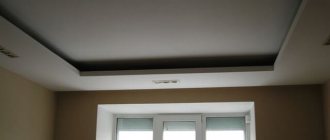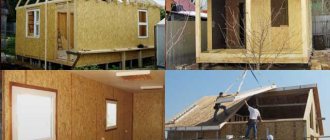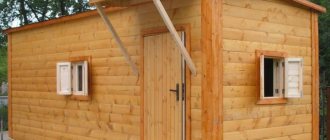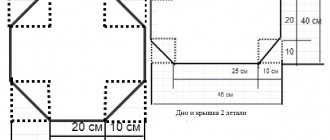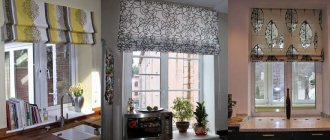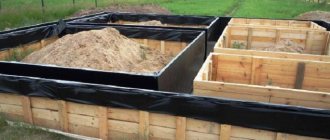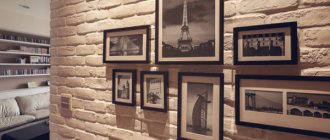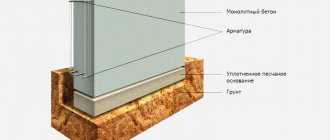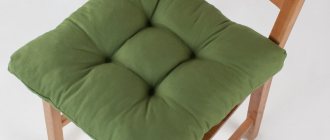Advantages and disadvantages of PVC panels
The plastic panel has the shape of an oblong rectangle. It consists of two PVC sheets connected by jumpers, which also act as stiffeners. Due to this, a void is formed inside the panel, which ensures its low weight. Thanks to this, the material is easy to transport and install. But this is not its only advantage; additionally, we can highlight the following:
- Wide range of applications. In addition to their direct purpose - finishing walls and ceilings, the panels are actively used to create window slopes, screens for bathtubs, and as formwork for non-standard steps - whatever the craftsman’s imagination is enough for;
- many options for colors, patterns, designs and textures. If desired, you can apply any image using photo printing for a specific order. The panel design possibilities are unlimited;
- Easy maintenance – the smooth surface can be easily cleaned with a damp cloth. If necessary, you can use dishwashing detergent. The only difficulty is cleaning the seams. But if you purchased high-quality seamless panels, this problem will not affect you.
Flaws:
- low resistance to ultraviolet rays - over time the plastic may turn yellow;
- poor resistance to mechanical stress - it is very easy to pierce and pierce the lining;
- When burned, the material releases toxic substances.
How to cover a toilet with plastic panels
Toilet repair with plastic panels
Today, plastic panels are widely used for various types of repairs. Their main advantage is the design principle, which allows the panels to be disassembled if necessary. Thanks to the design of plastic panels, the improved walls will be able to “breathe”, and this is important in conditions of increased humidity. The enormous popularity of this material was ensured by its cost-effectiveness compared to tiles, wallpaper, and stone.
Preparation for repair
Repairing a toilet with plastic panels takes 1-2 days. First, you need to decide on plastic panels with a thickness of 8 mm, which are much more practical than 5 mm ones. After all, the smaller the thickness of the PVC panel, the more likely the lock to break during assembly, which contributes to the appearance of cracks at the joints. The amount of plastic needed will depend on the perimeters of the room, but you will need to add 10-15% of the material, since there will be a lot of scraps during the work. When working, you need to pay attention to the water supply, which must remain open or have unhindered access.
When covering the toilet, metal profiles UD and CD are used. In addition, dowel-nails 6x40, hanging brackets for fastening the profile, white silicone glue, press washers measuring 3.9x16 will be useful.
The tools that will be used are: grinder, water level, hammer, hammer drill, cutter.
Installing panels on the ceiling
Repairing a toilet with plastic panels with your own hands is quite simple. You just need to consistently carry out the following actions:
- assemble a frame consisting of a metal profile for attaching plastic panels to it;
- we beat off the ceiling level line using a water level;
- We fix the UD profile along the ceiling line using dowel nails. Next, using press washers, we attach the CD profile to the UD profile. Each strip of the CD profile must be mounted at a distance of 60-70 cm and adjusted in two places so that the ceiling does not sag over time;
- It is recommended to start the set of panels from the side with the best view, because with a high degree of probability the last strip will need to be cut.
- width 12.5-50 cm
- length 260, 270 and 300 cm
- thickness 8, 9, 10, 12 mm
First, we attach the starting strip, from which we will begin installing the plastic. We attach each strip of plastic to the CD profile with a press washer.
You need to be very careful with plastic, which is fragile and can break the lock if you move it carelessly. You can view a video and photo of toilet renovation using plastic panels in this article.
Wall repair
The principle of working with walls is similar to the process on the ceiling. First, we assemble a metal frame from profiles, taking into account all levels. And don’t forget to make a vertical partition, which will increase the rigidity of the structure. To join the strips at the corners, an internal corner is used. As in the case of the ceiling, we start installing plastic from the side with the best view. The outer corner is used in the process of joining plastic, when repairing a toilet with plastic panels, to cover the sewer pipes. The upper skirting boards or baguettes are fastened with silicone glue, but the lower ones can be fixed with dowel nails.
Photo of toilet renovation with plastic panels
Video of toilet repair with plastic panels
Nice thermal panel theme! Quickly warm and reliable! There are also thermal panels made of ceramic concrete that made the office simply cool.
I built a house from aerated concrete and am going to cover the outside with thermal panels. Who has already installed them? How are the results? Or it may be easier and cheaper to make a wet facade, although it is not.
Thanks for the detailed instructions! I have an old washing machine lying around at my dacha. It will be necessary to use the motor from it to create an emery machine. Unity
Interesting design solution, I'll take note! The only thing I didn’t like from what I saw in the photo was that such tiles are used as a backsplash in the kitchen. Very good
This style reminded me very much of the film The Great Gatsby, in which the interiors of houses and apartments in the 1930s were decorated very luxuriously and pompously. Of course, this was a prerogative.
Plastic toilet panels as a wall finishing material serve as an excellent alternative to traditional ceramic tiles. In addition, this finishing method will save your budget, because the price of PVC panels is much lower than the cost of ceramics or natural stone.
Types and characteristic features of plastic panels
Panels are made from polyvinyl chloride by pressing the original liquid mass through a molding hole. As a result, the product has an air space that reduces weight.
Manufacturers offer the following standard sizes (see also -> photo of PVC panels):
The scope of application divides the panels into wall and ceiling. The former are more durable, resistant to mechanical damage. Ceiling ones are flexible and light weight.
The coating method allows us to produce products with a pure white surface, varnished, with a pattern using the thermal film method and in a typographic way.
Seam panels are chosen for decorative rooms when visibility of the joint is required. Seamless models create a single surface on which the joints are practically invisible.
Advantages of using plastic panels
Plastic panels are a fairly popular finishing material. And all this is due to the presence of a large number of distinctive qualities, namely:
- Simplicity and ease of installation. When installing PVC panels, a minimum of tools is required. The work process is completed quickly and effortlessly, since no preliminary leveling of the walls is required. The panels are easy to cut and saw, so they can be used to decorate a room of any configuration.
- Versatility . Plastic panels can be used to cover walls in the bathroom, kitchen, balcony (loggia), hallway, and toilet. Very often they are used on the ceiling, thereby covering the unevenness of the floor slabs. Often, after finishing, excess panels remain and are used in the bathroom.
- A wide range of color palettes and material textures. The stores offer panels with a glossy and matte surface, with imitation of natural stone and ceramic tiles, brickwork and wooden beams. The offered range is able to satisfy the needs of the most demanding customers.
- Low cost. Consumers with different income levels can afford to buy the panels. The price of this product depends on the manufacturer and quality of the material.
- Reducing financial costs when renovating a bathroom, kitchen, toilet, balcony. Due to the low cost of the panels, the cost of repair work will be significantly lower than when using ceramic tiles, natural or artificial stone, or wood.
- Resistance to high humidity. Plastic panels are not afraid of water, temperature changes, mold and mildew. They can be used even in unheated rooms. When temperature changes, the surface will not lose its brightness of color and will not deform.
- Long service life. Manufacturers provide a 20-25 year warranty on their products. As a rule, owners of apartments and private houses make renovations in the bathroom or kitchen every 10-15 years, which means that the warranty period for PVC panels is quite sufficient.
- Easy to maintain and use. Caring for a plastic surface does not create much trouble for housewives. For washing, you can use a soap solution or dish gel. The main thing is that the cleaning product should not contain abrasive particles or aggressive substances.
In addition, plastic panels are an easy way to cover toilet pipes.
And yet there are disadvantages:
- Plastic panels are attached to guide strips, which “eat up” the usable space in the room. For separate bathrooms in standard apartments, this is simply terrible.
- In the event of a flood from above, it is difficult to dry the room. Water will seep through the interpanel seams and will evaporate for a long time. This may pose a risk of mold growing under the panels and may require partial removal.
- The design of the tiles in the toilet in the photo and in real life will look better than its imitation from PVC panels.
How to cover a toilet with plastic panels?
Decorating a toilet with plastic panels is not at all difficult; you can do it yourself if you have the necessary tools, free time and skill.
To work you will need:
- plastic panels, edging profile and decorative fittings;
- plastic slats or aluminum profile;
- self-tapping screws with wide heads at the rate of 1 piece per 0.5 m of profile;
- electric drill and screwdriver;
- building level;
- panel cutting knife or jigsaw;
- Ruler and pencil.
Before purchasing panels, the area of the toilet in which the finishing will be done is calculated. To the resulting calculation, another 15 percent of the material for the cuts should be added.
Preparatory work
In order to panel the toilet correctly, it is necessary to carry out preparatory work. Experts recommend removing old finishing material from the walls, thereby increasing the usable space at least a little.
It is better to immediately replace old water pipes and electrical wiring even before installing the sheathing. It is recommended to pre-treat the walls with a primer, which will prevent the appearance of mold and mildew.
It is necessary to think in advance where the cabinets, sink, etc. will be located in the future. In these places, additional strips should be provided on which accessories will be attached. The panels must be kept at room temperature before installation.
Installation work
First of all, guides made of aluminum profiles or plastic slats are attached to the walls. The wall lathing is mounted horizontally, the ceiling lathing is mounted perpendicular to the direction of laying the panels. The step between the guides should be approximately half a meter. Some designers create diagonal fastening of plastic panels. In this case, more material will be required.
The U-shaped and corner profiles can be fixed immediately. The first panel is carefully inserted into the outer U-shaped profile and attached to the guides with self-tapping screws. Some craftsmen fasten the panels with a construction stapler. However, this is applicable for wood sheathing which is not suitable for a toilet.
Step by step, the following panels are attached, which are pressed tightly against the previous ones. The most crucial and difficult moment is attaching the last panel. You will need to accurately calculate its remaining width. In the wrong hands, an entire structure can be ruined.
The ceiling is covered after finishing the installation work on the wall. If spot lighting is provided, holes are pre-cut in the panels according to the size of the lamps. In addition, holes will be necessary for installing sockets and switches, in places where pipes and ventilation pass. Cutting the material must be done from the front side. For these purposes, it is best to use a jigsaw or hacksaw with a tooth pitch of 1 mm.
After fixing the plastic panels, a decorative plinth is installed, which can be made of plastic or ceramic.
When choosing panels for finishing a toilet room, you should not go for cheapness. A very low cost of a product indicates its poor quality. Moreover, the material may contain substances harmful to the human body.
Photo of plastic panels in the toilet
How to finish a toilet using plastic panels
If you decide to repair a toilet using plastic panels, do it yourself. Sheathing walls and ceilings with these materials is not at all difficult, and even a non-professional can do it. As a result, you will receive a large number of advantages, and the finishing itself will cost you several times less than using ceramic tiles.
DIY bathroom ceiling in 15 minutes
What is plastic lining?
White plastic lining
Plastic panels intended for toilets are lining, which are lightweight and made of PVC materials. It can be used to decorate both walls and ceilings.
The outer surface of the lining is smooth, and can be matte, glossy and even mirrored. A large assortment of materials and a variety of colors allows you to apply any design to decorate your bathroom. In this case, the plastic surface can be:
PVC lining
- white, matte;
- white, glossy;
- with imitation wood, marble and other expensive finishing materials;
- with a pattern that is applied to the surface using a special film.
Inside, these toilet modules have a porous structure. Their thickness ranges from 8 to 12 mm, length – from 2.5 to 6 m, and width – from 0.1 to 0.3 m. This variety allows you to apply any design when decorating a toilet.
Advantages and disadvantages of this material
Finishing the toilet with plastic panels allows you to get a large number of advantages:
- Sheathing walls or ceilings with such material is very simple, because one module is light in weight. You can carry out the installation yourself without outside help;
- the cost of this material is low. Covering surfaces in this way will cost 3-5 times less than using tiles;
- when using plastic modules, there is no need to additionally level the walls and ceiling;
Auxiliary elements for installation of lining - high humidity is not able to destroy the plastic, which makes this cladding durable. Manufacturers guarantee that this material will last at least 20 years;
- This cover is easy to use. It can be easily washed using regular detergents;
- behind plastic panels you can hide a variety of communications - water supply pipes, sewerage pipes, electrical wiring.
The main disadvantage of this material is its low combustion resistance. Most often, plastic is not flammable. But when exposed to high temperature or fire, it begins to smolder and melt. This releases toxic gases that are very dangerous.
Toilet cabin trimmed with PVC lining
Statistics show that more than 70% of people are infected with parasites to one degree or another, in order to get rid of them you need to drink in the morning.
Also, finishing the toilet with plastic panels will steal at least 3-4 cm on each side. If there are large irregularities, the width of the room is reduced even more. Therefore, this material is not suitable for a bathroom with a small area.
What design solution can be used for the bathroom?
The design of the room when using plastic modules can be varied. This material can be used to cover all surfaces from the ceiling to the walls, as well as a small part of them. For example, install the panels on the wall from the floor to half the height of the wall. On the upper part you can apply cladding using putty. This way, you can easily clean the room. The lower part, which gets most dirty, can be easily cleaned using detergents and disinfectants.
One of the options for finishing bathroom walls with PVC panels
You can also use modules that, after installation, form a pattern. In this way it is easy to create a cozy atmosphere using any room design. Panels that imitate expensive cladding made of wood, granite or stone look good. In this case, the design of the bathroom will be very successful.
Necessary materials
Repairing a toilet with plastic panels with your own hands is very simple. The design of the room needs to be thought out in advance, since the choice of specific materials depends on this.
Auxiliary elements for installation of PVC lining
In this case you need to purchase:
- required number of PVC panels;
- edging elements;
- accessories for surface decoration;
- slats for creating a frame - wooden, aluminum, plastic;
- dowels;
- self-tapping screws - you need to choose ones with wide heads at the rate of 2 pieces per 1 linear meter of profile.
It is also necessary to prepare tools that will help carry out installation as quickly and correctly as possible. To do this, take a building level, tape measure, jigsaw or hacksaw, screwdriver, drill.
Surface preparation
Before installing PVC modules, it is necessary to remove old finishing materials from the walls and ceiling. This will help increase the usable area in the room, which subsequently decreases significantly.
Also be sure to repair the plumbing, sewer system and electrical wiring. Replace old pipes and cables, check the quality of connecting elements. This will help extend the life of the finish. In the event of an emergency, it will be necessary to completely dismantle some of the panels, which most often become unsuitable for further use.
To prevent the formation of fungus and mold on the surface of the walls, be sure to treat them with a primer. The design of the room must be thought out in advance, since additional strips need to be fixed in the place where the washbasin and cabinets are installed.
Frame installation
Making a frame for this design is very simple if you follow the following recommendations:
PVC panel installation technology
- When using wooden slats, treat them with an antiseptic solution. This is best done the day before installing the frame. Treat it outside with a liquid that prevents the formation of fungus and wait until it dries.
- Along the perimeter of the room, at a distance of 2-3 cm from the ceiling, you need to attach slats or a UD profile. In the latter case, you need to use dowel nails. Fasten the profile every 0.6-0.7 m.
- Fix the following slats in a horizontal position towards the floor. Install them every 0.5 m. Attach them to the wall in the same way using dowels.
- Install a U-shaped profile on top of the sheathing in the corners of the room.
Toilet lining
Making a reliable coating from plastic panels is very simple. Before installation, cut each element so that its length is 1-1.5 cm shorter than the height of the room. This shortage of material is compensated for by installing decorative strips.
The cladding process consists of the following stages:
Installation of PVC panels
- Install the starting panel in the desired place, while the narrow shelf should be inserted into the profile, which is located in the corner of the room.
- Using self-tapping screws, attach the panel to the frame at the location of the wide strip on the surface of the lining.
- Thus, install all plastic modules.
- Additionally, install finishing strips near doorways and in the corners of the room.
Only after covering the walls can you begin installing the panels on the ceiling. Installation of the frame in this case is carried out in the same way. In this case, along the perimeter of the ceiling you need to attach a special strip for mounting the baseboard.
The panels are connected to each other using a special lock and screws to the frame. In this way, you can install the plastic lining in the toilet yourself.
Partner advertising
IT IS IMPORTANT TO KNOW! 7 out of 10 people are infected with parasites! To remove them you need to drink 2 teaspoons... Read more—>
Video: Design and finishing of a toilet with plastic
- How to decorate a toilet with plastic panels How to decorate a toilet using plastic panels If you decide to repair a toilet with…
- Design of a toilet decorated with plastic panels Advantages Cons Color solutions Tips Examples of competent designs Plastic panels are one of the most…
- How to decorate a toilet with plastic panels with your own hands Plastic panels for toilets as a material for wall decoration serve as an excellent alternative to traditional ceramic…
- How to cover walls with plastic panels How to cover walls with plastic panels with your own hands As an environmentally friendly and natural material…
Types of material
Plastic panels differ in several parameters:
- depending on their area of application. They produce products for walls and ceilings. Wall slats are more durable and therefore better able to resist impacts. In addition, they are less flexible than ceiling counterparts, which is very important, since after installation in a vertical position the cladding can move. The fact is that thicker and harder plastic is used for their manufacture. The thickness of the stiffeners in such products approaches 1 mm, which also increases the stability of the material;
- in size - the width of the plastic can be 125, 250 or 380 mm. Medium is considered optimal, but it is much more convenient to work with wide slats. The length of the panels most often ranges from 2.4 to 3 m. The thickness of products for the ceiling can be from 6 to 10 mm, and for walls - from 10 to 12 mm. If you want to install spotlights on the ceiling, it is preferable to choose panels with a thickness of more than 8 mm. Thinner ones will show through and the sheathing will be visible through them;
- by texture - laminated or simple. The former are more resistant to damage and contamination. This is ensured using a protective film. This material is of a high class; most often it can only be purchased in decor studios. In terms of durability, it may well compete with tiles.
Preparatory work
If the walls are smooth, then the material can be laid directly on the load-bearing surface. Although this option is extremely rare, so most often most of the time is spent on installing the frame. Finishing a toilet with plastic with your own hands begins with installing the frame; for this you need:
- First you need to remove the old finish down to the concrete or brick base. Be sure to remove the tile cladding; if you do not remove the tiles, then over time they will fall off, but under the new cladding. If the walls are painted and the paint adheres firmly, then there is no need to beat it off, it will not interfere.
- Inspect the surface for cracks; if there are any, they must be opened, cleaned of debris, and then filled with a repair compound. You can do this with cement mortar or use inexpensive tile adhesive.
- To protect yourself from the appearance of bacteria or fungi under the panels, you need to treat the surface with any antiseptic. Experts recommend doing two impregnations with a time interval of 6 to 12 hours. During this period, the walls just have time to dry well.
- If you plan to lay the sheets on the ceiling, then pre-stretch the wiring for the lighting fixtures. The cable is placed in special protective covers that will protect the wire from moisture. Then they are fixed to the base ceiling with plastic clamps or using wire hangers.
After the walls and ceilings have been prepared, the construction of the frame begins. For this you can use metal or wooden profiles.
Tips and tricks for choosing
When choosing plastic panels, you should first of all pay attention to the composition of the products. The material for high-quality lamellas contains chlorine, hydrogen and carbon. Sometimes the composition includes bound lead, which performs a stabilizing function. Such panels do not release toxic substances into the air during a fire with high heat.
We recommend purchasing panels made of hard plastic - they are not flammable, in addition, they have excellent sound insulation characteristics and increased resistance to temperature.
A visual inspection will provide sufficient information about the quality of the material. Inspect the slats for:
- uniformity of coloring;
- the presence of black spots on the surface;
- the same width;
- absence of defects - drops, waves, chips, unevenness;
- integrity of the locks.
If you choose a product in an online store and you do not have the opportunity to inspect it yourself, get information from customer reviews of this company.
To test the strength of the material, press on the plastic. If only a small dent remains, the quality of the panels is satisfactory. Significant deformation and cracks indicate that such panels do not have sufficient strength and will not last long.
Recommendations for choosing plastic panels
How strong PVC panels will be depends largely on how many ribs the product has. You should know that the more there are, the higher their strength characteristics.
By choosing a lining that is 8 mm thick, you get a material that is not only highly durable, but also highly resistant to deformation during installation.
In order for the color shades of the purchased material to match, it is necessary to purchase finishing material from a batch of the same number.
When choosing panels for bathroom renovation, you should pay attention to the color of the products. It should be uniform, and the pattern that is present on the front side of the material should be clear.
If the bathroom in your apartment has a small area, then you should not choose products in dark shades to decorate it with plastic panels. If you use such material, the free space in the room will be visually noticeably reduced. To make a small room seem larger, the walls in it during renovation should be decorated using finishing materials in light shades with a beautiful pattern.
The high price of the selected material should not be taken as an indicator of good quality. But you shouldn’t choose inexpensive products either. The golden mean is the optimal choice.
It is better not to choose too wide plastic panels for finishing the bathroom. The maximum value of this parameter should be no more than 15 cm.
When purchasing plastic panels for bathroom renovation, in addition to them, you should immediately purchase fittings. Moreover, it should be the same color as the plastic panels. The strength of the lining, as well as the aesthetic appearance of the room in which it will be used, largely depends on the corners and endings used.
You should choose even slats that will be used to create a frame for the panels. If you use crooked products to renovate a bathroom, you will not be able to create a high-quality base for creating an even finish.
Matching style and design
When choosing a material for finishing a bathroom, you must take into account the general style direction of the house or apartment. In classic interiors, plastic will look alien. The same can be said about country, art deco and Provence. In these styles, it is better to use plaster, natural wood or tiles. But in modern styles - minimalism, modern, high-tech, plastic is quite acceptable and is used very actively.
The design of the lamellas - a wide color palette, various patterns and images, including 3D, imitation of tiles, stone, natural wood, mosaics - provides an extensive field for bringing the most creative design ideas to life. Modern manufacturers are trying to take into account all the latest trends in interior art.
Color variety of panels
If a plain cladding seems boring to you, you can add additional shades to the interior. They can be either close and differ only in saturation and depth of color, or contrasting. Combinations of representatives of a bright palette with calm shades of a neutral range - white, gray, sand, black, beige - always look advantageous. Silver or mirror inclusions look great.
The latter also have purely practical benefits. A skillful combination of colors allows you to visually adjust the shape and size of the room. Narrow walls will look wider if plastic is laid in contrasting horizontal stripes; dark walls decorated with white accessories will visually “step back” and add volume to the bathroom. At the same time, light shades will visually enlarge the room.
The technique of combining shades can be used not only to decorate walls, but also to highlight individual zones. You can select an area with a toilet, sink or hygienic shower.
Combinations of shades are appropriate in any style. The main thing is to choose the right colors that are destined to become companions. For example, these:
- blue color - looks great next to white, black, blue, turquoise - this design will be ideal for a Mediterranean-style toilet;
- brown - combines well with yellow, sand, beige - these colors are typical for classic decoration;
- red shades can be emphasized with white, black or cream paints. Such combinations are suitable for modern styles - hi-tech, pop art;
- metallic - a shade of gray in combination with any shades will fit perfectly into minimalism and loft;
- green - in combination with golden and brown tones, suitable for styles that gravitate towards nature.
A combination of several shades can be arranged in a checkerboard pattern, outline geometric shapes, diagonals - the possibilities for experimentation are extremely wide. Design options for bathrooms using panels of different colors are presented in the photo.
Calculation of the required quantity
To correctly determine the amount of materials needed, you need to measure the room and determine the area of the walls that need to be lined. This number must be divided by the area of one lamella. This way we will know the required amount of material. But such a calculation is rough; a more accurate result can be obtained if you perform the same operation on each wall separately. Don't forget to subtract the area of the doorway and, if necessary, the window opening.
The resulting number must be rounded up and added to the result by 10-15%. The supply will be used for trimming, accidental damage and possible need for replacement.
Mounting options
When installing panels, two methods are used. The elements are fixed either with glue or with lathing. Let's look at each of these methods in more detail.
With glue
The easiest way, which will take a minimum amount of time and effort, is to glue the panels using liquid nails. In this case, the material is fixed directly to the wall, which saves maximum space. And this is a significant bonus for such a small room as a toilet. The only condition is that the base must be as level as possible. Unevenness of a maximum of 5 mm is allowed. Otherwise, it will be impossible to achieve complete adhesion to the wall. The slats in this place will sag and peel off very quickly.
When choosing such a technology, it is necessary to take into account the microclimate in the room. High humidity will inevitably lead to the appearance of fungus. Due to constant contact with the wall, condensation will form under the plastic, which simply cannot evaporate due to the waterproofness of the material.
This method has another drawback. During subsequent repairs, it will be very difficult to remove the cladding from the wall.
If you have smooth walls and you do not plan to change the finish soon, the method of installing panels using glue will be the best choice for you.
The installation process is carried out in several stages.
- Preparing the foundation. We clean the wall from dirt, dust, glue residues, old wallpaper, and greasy stains.
- Apply the adhesive composition in strips to the back side of the product.
- We apply the panel to the desired section of the wall, with force, but gently press it and hold it for several seconds.
Choose adhesive compositions that provide maximum adhesion of the base to the finishing material. The best choice would be “liquid nails” sealant.
With sheathing
If the toilet has uneven walls, you will first have to prepare a frame-sheathing, and then attach the panels to it using self-tapping screws, clamps or staples.
Wooden beams or a metal profile are suitable as materials for the frame. The first option is more convenient because it can withstand any fasteners used when installing slats. While only self-tapping screws are suitable for covering a metal profile.
The sheathing elements need to be fixed at a distance of 35-40 cm. They are fixed using dowels or self-tapping screws, depending on the material chosen for this.
Next, we mount the panels on the frame. This can be done with:
- small nails - driven into the technological tongue under the groove. The disadvantage of this method is difficult dismantling and the risk of damaging the lamella with a hammer;
- staples of a professional stapler. A quick and convenient method - but only suitable if the sheathing is made of wood;
- clamps - fastening elements in the form of clips that securely fix the panel even in a new building that is about to shrink;
- self-tapping screws - suitable for any frame.
Once the material for the sheathing and sheathing has been selected, you can proceed to installation, which is performed in several stages:
- install slats on the wall;
- we install fittings for decorating external and internal corners, finishing elements;
- we install the panels by inserting each of them into the mounting groove with a narrow shelf, after which it is fixed on the sheathing through a wide shelf;
- The final panel is placed between the previous and the final module with little effort.
The panels must be installed strictly vertically and as tightly as possible, avoiding bending.
The process of finishing a toilet with plastic panels
Tools
In the process of finishing surfaces we will need the following tools:
- screwdriver;
- building level;
- plastic panels;
- fasteners;
- wood blocks.
Wall decoration
- At the very beginning, wooden blocks are mounted on the walls of the toilet. They will become a kind of basis for arranging plastic panels. It is important to pay attention to the fact that if the panels are positioned vertically, then it is advisable to fill the bars parallel to the floor level. If the material is positioned vertically, then the wood elements are mounted perpendicularly. Experts note that this determines how even the arrangement of the plastic panels will be. It is worth calculating the most successful step between the wood blocks so that too much material is not used for this task, and at the same time, the reliability of fastening plastic products is at its best.
- It is advisable to attach the wood blocks themselves directly to the walls using dowels or self-tapping screws. In the second case, you will need to drill holes and only then drive plastic choppers into them. It is also important to say that you should take the choice of wood itself seriously. We can talk about wooden blocks that are not sufficiently dried. In such a situation, after some time, the material may warp. Accordingly, this will ruin the entire appearance of the space, and after that another repair will have to be carried out. Returning to the question of the step between wooden elements, it makes sense to create a distance of about 40-50 cm. In some cases, additional loads are created on the walls (hanging shelves, fasteners for TVs), and in this situation it is advisable to reduce the step so that the structure can withstand additional loads.
- Next, you need to decide on the method of attaching the plastic panels. In some cases, it is advisable to pay attention to fastening by using a construction stapler. You can also apply special glue to the wood blocks and then press them to the surface of the panel. Accordingly, all that remains is to complete the most important thing. In this case, it is worth paying attention to the fastening of the panels to each other. Often plastic products have special locks that allow you to create a single design. In order to hide the edges of the material, as well as reliably limit the surface of plastic panels, special profiles are used. By the way, there are several types, each of which is the most optimal option in a given situation. For example, if the panels reach the very ceiling, then it is advisable to use a ceiling plinth.
Other details
It is extremely important to analyze the issue related to some specific aspects of the repair work.
- Often, owners decide to fasten panels by hammering nails into them. This process should be carried out extremely carefully, since even light hammer blows can create dents in the material.
- Plastic panels are often cleaned using a soap solution. The use of various abrasives means serious damage to the material, which absolutely should not be allowed.
- If plastic panels are attached using glue, then it should be applied directly to the walls (or to the bars). On sale you can find special glue “liquid nails”, with the help of which the necessary process will go as smoothly as possible.
Step-by-step instructions for finishing a toilet with your own hands
Before you begin installing the panels, read the step-by-step instructions.
Required materials and tools
To decorate the toilet with plastic panels you will have to stock up on:
- material for creating the frame - it is advisable to give preference to slats or metal profiles with a cross-section of 20x50 mm. The thin profile will allow you to save maximum space in the toilet or combined bathroom. When calculating the number of slats, you need to take into account the ceiling frame, as well as the decorative box that masks the pipes;
- dowels for securing a beam or profile - the reinforcement should be of such length as to extend into the wall by 50-60 mm. The amount of fasteners is determined depending on the dimensions of the frame, taking into account the step at which they will be located;
- 15-20 mm wood or metal screws, or small nails or a construction stapler with 10-12 mm staples;
- Liquid Nails sealant or tile adhesive - if the walls are smooth;
- means for treating wooden structural parts against rotting and insects;
- primer for treating ceilings and walls - enhances the strength of the base, increases the adhesion of the adhesive to the wall. If you choose a composition with antiseptic properties, you can reduce the possibility of fungus formation.
The set of tools varies depending on the chosen installation method and may consist of:
- hammer drill or electric drill;
- drill for wood or concrete;
- screwdriver;
- jigsaw or saw;
- hammer;
- metal scissors;
- construction knife;
- tape measure and square;
- pencil or marker;
- level with vertical and horizontal indicator;
- construction stapler;
- spatulas, roller, brush, hair dryer.
Preparing the walls
Before starting installation, it is necessary to prepare the base. The old finish is completely removed from the wall surface. After this, the walls must be cleaned and treated with an antiseptic to prevent the formation of fungus. After this, you need to fill all the unevenness and cracks with plaster or putty and wait for the material to dry. If the technology of installing panels on glue is chosen, it is necessary to level the walls using plaster or drywall. For the toilet, the first method is advisable, since the frame, together with the gypsum board, will “eat up” a fair share of the space. Before pasting on a wall – plastered or mounted from plasterboard – it should be primed.
Installation of sheathing
If you are not bothered by the loss of usable space, choose the method of mounting on the sheathing. This will make it possible to hide unaesthetic communications and supplement the design of the facing “pie” with heat and waterproofing materials. If the toilet is combined with a bathroom, the humidity in the room is increased. Therefore, it is better to choose metal or plastic profiles to create the frame. If you still decide to choose wood, treat the surfaces with moisture-proof, antiseptic and fire-retardant compounds and finally paint them.
Installation steps:
- We carry out the markings. The outermost slats - upper and lower - will be located at a distance of 6-7 cm from the floor and ceiling. We mark the ceiling in the same way. The supporting slats must be installed perpendicular to the slats, which can be installed vertically, horizontally or diagonally. The step is 40-50 cm.
- We mount the frame using self-tapping screws or dowels.
- We carry out the wiring and bring it out to the planned places.
- Insulation can be laid in the gaps of the frame.
- We make boxes to hide the pipes.
- We install a vapor barrier membrane.
- We cut panels and moldings according to the height of the room. During installation, we adjust and cut additional elements.
Panel installation
The sheathing is ready and it’s time to start installing the decorative panels. It is performed in several steps:
- install corner and side moldings;
- we attach the starting profile in the far corner from the front door;
- we insert the first lamella into it with a narrow shelf, begin to insert the element from the bottom corner;
- we fix the panel using suitable fasteners - clamps, staples, self-tapping screws, observing a step that can ensure rigidity of the structure;
- We install subsequent panels in the same way. During installation, it is necessary to monitor the tightness of the fit - the joints should not be obvious;
- We frame window and door openings with starting corners;
- We attach skirting boards that will decorate the cracks and give completeness to the appearance of the room.
When installing panels using a seam method or if the joints have become visible due to uneven walls, the joints must be sealed with silicone.
Installation of wooden sheathing under plastic panels
First of all, you need to completely clean the walls and ceiling of the toilet from old finishes or paint. This is done using a spatula and a light hammer, which is used to tap the surface. A coating that has become unusable will immediately disappear.
Read more: How to start renovating a room
Next, the bars are prepared. They must be cut to the required length based on the horizontal attachment to the wall. When all the wooden elements are ready, they are treated with impregnations and taken out to dry on the balcony or staircase.
Important! The size of the bars should be a few centimeters smaller than the toilet room. This is necessary so that the tree has the opportunity to expand.
In the meantime, while the bars are drying, there is time to continue preparing the walls in the toilet for finishing. They need to be treated generously with an antiseptic primer; it prevents the formation of mold and harmful fungi. Impregnation is done using a foam roller. It takes about an hour to dry completely at room temperature, which means you can take a short break and catch your breath.
If the ceiling in the toilet will also be finished with plastic panels, then lathing is needed on it too; the fastening technology is no different from the wall one:
- The block is applied to the surface, and using a hammer drill, a hole is drilled through the tree into the hay. The first fastening should be approximately five cm from the edge. A dowel is driven into the hole. The second edge is attached in the same way. Now that the block is fixed, it is further strengthened, with a step of 30-50 cm between dowels.
- When the bars around the perimeter of the toilet room are installed, use a tape measure to measure the distance between the lower and upper bars. It is divided into two, and another beam is attached exactly in the middle of the wall.
- The resulting two sections are once again divided in half, and the beam is placed again. This is done until the distance between the guides is approximately 50 cm.
- Certain difficulties may arise with communications, which also need to be finished with plastic panels. To do this, boxes are made from the same block as the sheathing, which are attached to the wall and floor of the toilet. You can connect the bars together with wood screws.
Advice! if spotlights are planned as ceiling lighting in the toilet, the block must be mounted below the ceiling, at least 15 cm. This is done using profile fasteners.
You can watch the video in more detail on how this is done.
All finishing strips are fastened with staplers to the bars
When installing plastic panels in a toilet with your own hands, always start from the left edge and the ridge to the corner. Using a construction stapler, fastening brackets are driven into the corner groove and ridge on the other side of the panel.
Important! The first panel must be installed strictly in level. All other finishing elements will be oriented towards it.
The second plastic panel is inserted into the groove of the first and its ridge is also fixed with brackets along each wooden guide. All stages of installation are clearly shown in the video
After the walls of the toilet are completely covered with panels, the boxes covering the communications are finished. Here, perhaps, each panel will have to be cut to length; subsequently, these places will be covered with decorative corners.
In the same way, plastic panels are installed on the toilet ceiling. But here it is important to immediately make holes in the places of the lamps and bring the electrical wires out.
Plastic glue is applied to the corner and applied to the junction of the panels. Good glue sets in a few seconds, so it is important to have time to glue the corner before it dries.
Using the same glue, floor and ceiling skirting boards are fixed. Any excess glue can be removed with a soft cloth, and at this point finishing the toilet with plastic panels with your own hands can be considered complete.
The matter remains with installing the necessary accessories and lamps, but this is a topic for another discussion.
Attention! It is very difficult to subsequently remove the glue from the walls, and therefore changing the panel and installing a new one will not be so easy and you will have to carry out rather complex and time-consuming dismantling work. When choosing glue for installation, you should take this nuance into account.
Finishing toilet walls with plastic using hidden staples. There is another interesting fastening option that can be used to decorate the walls with plastic in the toilet, this is the use of special fastening brackets. But this option is ideal only for well-leveled walls or finished with plasterboard. So:
- Do-it-yourself mounting on the guides is simple. Installation of plastic panels is also done using special guide rails, which serve as the basis for the plastic. Slats can be made of both wood and metal, and you can choose the material based entirely on your preferences, tastes and capabilities.
- In this case, there is nothing complicated, since slats are attached along the entire length of the wall, onto which the panels themselves are subsequently installed.
Installation of plastic panels
- Using a screwdriver, with an approximate step of 50 cm, a guide profile is mounted with self-tapping screws, then the U profile, as well as external and internal corners, are fixed on the floor and ceiling. Self-tapping screws or using a construction stapler (in case the frame is wooden) are suitable as fastening elements.
- After installing the frame, plastic panels are inserted into the profiles and secured with special locks.
Tip: Fixation must be done very carefully, since rough installation work can break the lock.
Everything is very simple, understandable, even a beginner can handle it, and the price of such an installation will be very low, since nothing special is required here.
Important: Before installing, take into account the location of the radiators in your toilet; if heating radiators are placed under the panels, there must be a small gap between them and the plastic panels, otherwise the panels will deteriorate very quickly.
Thus, plastic panels are a great way to decorate your bathroom beautifully and inexpensively. They will look great in the toilet, and are perfect both as a temporary option and as a permanent design option, an alternative to tiles. In addition, plastic panels are very easy to change to others, which is also convenient for fickle people who do not want to live in the same environment.
Read How to glue meter-long non-woven wallpaper
Graduated from the Faculty of Architecture of the Penza State Institute of Architecture and Construction. For the last ten years, he has been a leading specialist in a large construction company in Penza, engaged in the construction of multi-storey residential buildings. Total work experience in the specialty is 18 years.
Rigidity or strength is important because the walls will most likely be loaded with loads in the form of shelves and various accessories. Ask the seller to show more durable models; the higher the rigidity, the better.
Now let’s talk about how long and wide the panels should be. The average width of plastic panels is 12-25 centimeters. For a beginner with no masonry experience, it is recommended to take products about 14-15 centimeters wide. The length is always standard and equal to 3 meters.
Read more: Bathroom in Scandinavian style photo
For this type of material, you must buy endings and plastic corners. You cannot save on this purchase, since fasteners complete the overall look of the repair. It is better to take corners with a reserve.
On average, plastic finishing lasts about 10 years, so choose panels to your liking, but preferably neutral colors with patterns you like, because you won’t be using the room for a year.
The next important purchase is slats. It is recommended to buy slats with a square cross-section, this will provide additional strength to the frame. The slats should be straight, compare the entire stack you are going to buy. If you don’t have self-tapping screws, screws and nails like tar paper at home, you’ll have to purchase them.
This is the second stage from which you begin finishing the toilet with PVC panels yourself. Read the instructions supplied with the products; usually the manufacturer gives his recommendations for installation.
There is nothing complicated in preparing the surface: the main thing is that it is dry. If there was wallpaper in the toilet before, it needs to be removed. But if there were originally tiles, drywall or plaster on the wall, then you can sheathe over them.
If mold is present, the surface should be thoroughly cleaned and disinfected.
The lathing can be made of metal, plastic, wood. Which lathing is better? If there is high humidity in the room, then the wooden sheathing may not last long, but there is a way out - treat it with an antiseptic.
Plastic and metal battens are easier to work with because they are attached with clips. The slats should be perpendicular to the panels. The distance of the structural elements can be about 30 centimeters, but if necessary, you can safely increase it to 1.5 meters.
For any unevenness on the wall, it would be correct to place a wooden, plywood, or plastic spacer under the slats to secure it. You can insert insulation into the frame.
- wooden blocks;
- building level;
- screwdriver;
- plastic panels;
- screws, nails or glue.
First, wooden blocks are placed on the walls of the toilet. If the plastic panels are positioned vertically, then the bars are packed parallel to the floor. If horizontal, then the bars are packed perpendicularly. The bars must be set to the building level. This determines how evenly the panels will be positioned.
Installation of the frame on walls made of metal profiles
When planning how plastic panels will be mounted, you need to take into account that their vertical arrangement will visually make the room taller. And the horizontal one is wider.
Profile frame on the ceiling
The bars can be attached to the walls with dowels or self-tapping screws. If using self-tapping screws, then you need to drill holes and drive plastic chips into them. Wooden blocks must be well dried so that they do not warp later. After all, this could ruin the whole work.
Frame made of wooden blocks
The distance between the sheathing bars is usually 40-50 cm. If you plan to hang shelves or cabinets, then the sheathing bars are attached more often, taking into account the fastening of the shelves. This must be provided for in advance.
An alternative method is to attach the panels with glue.
Features of installing panels on the ceiling
Let's get acquainted with the specifics of installing PVC panels on the ceiling. The very first and most fundamental thing to decide is the distance between the cladding and the ceiling. When making your decision, consider the type of lighting fixtures you are going to install. If the lamps are built-in, leave at least 10-15 cm. A space will be created behind the panels where all the wiring will be hidden. The locations of spotlights should be marked with a pencil. After this, we cut out the holes and install the lamp bases.
Finishing a toilet with PVC panels with your own hands: preparatory manipulations, tools
To determine the required amount of cladding, you need to correctly measure the toilet in the apartment. You will also have to take care of the fitting profiles that will be needed to make corners, design joining areas near the floor and ceiling, create an inspection door, a cabinet, if required. The choice of molding design is, first of all, influenced by the intended design of finishing the toilet with plastic panels. Profiles can be connecting, starting, ceiling, end, external and internal.
The panels are installed on the sheathing - wooden slats 20x50 mm or metal profiles. The pitch between the vertical or horizontal guides of the frame is usually 50-60 cm. The lathing is fixed to the base using dowels; they should enter the wall by 5-6 cm. For the initial installation of PVC panels on the frame, self-tapping screws of 15-20 mm in size are used.
Options for finishing a toilet with panels include the possibility of using liquid nails or other adhesive compositions for tiles if the walls are initially perfectly smooth (that is, without lathing). Rarely does a toilet renovation in a Khrushchev-era building develop according to this scenario, but in panel houses there are chances.
If you plan to use wood for the frame, it is necessary to pre-treat it with compounds that prevent rotting and protect against damage by microorganisms. Walls and ceilings can also be initially primed to strengthen future cladding and protect surfaces from insects and mold.
List of tools:
- screwdriver, hammer drill, drills of different diameters for concrete and wood;
- jigsaw, hammer, tape measure;
- construction stapler and level;
- markers for marking;
- metal scissors (if this particular frame is chosen).
Spatulas and brushes will be needed to work with the primer; a hair dryer can also come in handy here.
Combining PVC panels with other finishing materials
Another advantage of plastic panels is their ability to harmoniously combine with representatives of other groups of finishing materials - paint, wallpaper, tiles, MDF panels, plaster. This material provides unlimited design possibilities in terms of creating all sorts of, sometimes unexpected, combinations. The most common example for a toilet is when the bottom of the wall is covered with tiles and the top is finished with plastic slats. Another option is to have panels on the bottom and the top is plastered. The border between materials can be closed with polyurethane molding.
Panel care
How to properly care for the panels, what products can be used and what forms of cleaning can be used depend on the type of cladding you have. Panels are:
- laminated;
- simple.
Both of these materials are perfect for finishing a toilet. Keep in mind that material without a laminated layer better absorbs dirt and stains that cannot be removed later. Therefore, you should get rid of new contaminants immediately after they appear.
Surfaces that do not have a protective film should be cleaned “dry”, that is, using the “dry” method. Use a vacuum cleaner or dry cloth. If the stain cannot be removed, dampen the cloth and treat the stain again.
Surfaces not protected by laminate should not be rubbed vigorously. The abrasions may not be very visible, but as soon as dirt gets on them, they will immediately appear.
Laminate flooring is cleaned in the same way. However, the presence of a protective layer allows you to apply more force when washing the plastic. Grease stains, dried blots and stains can be wiped off at any time, even if quite a lot of time has passed. If necessary, non-aggressive and non-abrasive detergents can be used. Avoid chlorine-containing compounds, as they can cause irreparable damage to the paint of the panels. You can use a homemade soap solution, dishwashing detergent, or a slurry made from water and baking soda - applied to the stain for a couple of hours, after which it is washed off with warm water.
You can also care for the panels using cleaning chemicals from the store. It can be either a solution or an aerosol.

